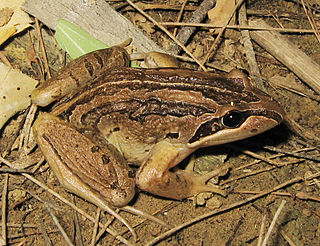
Limnodynastes is a genus of frog native to Australia, southern New Guinea and some Torres Strait Islands. They are ground-dwelling frogs, with no toe pads. The size varies from 45 mm to 90 mm in the giant banjo frog. The webbing on the feet ranges between species, from very little, to almost complete. The tympanum is not visible in any species, except in the woodworker frog, which is sometimes classed in a separate genus Megistolotis. All species construct a foam nest in which the eggs are laid. However, in south-eastern South Australia female striped marsh frog and spotted grass frog lack the flanges of skin on the hands that helps trap the air bubble and do not construct foam nests.
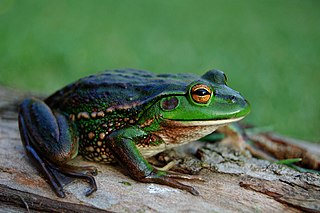
The growling grass frog, also commonly known as the southern bell frog, warty swamp frog and erroneously as the green frog, is a species of ground-dwelling tree frog native to southeastern Australia, ranging from southern South Australia along the Murray River though Victoria to New South Wales, with populations through Tasmania. This species' common names vary between states; the name southern bell frog applies to New South Wales, growling grass frog in Victoria and South Australia, and green and gold frog in Tasmania. This species has been introduced to New Zealand.

Fletcher's frog or sandpaper frog is a species of ground frog native to eastern Australia from South-east QLD to Ourimbah, NSW. It inhabits rainforest and wet sclerophyll forest of the coast and ranges.

The red-crowned toadlet is a species of Australian ground frog, restricted to the Sydney Basin, New South Wales. It is only found around sandstone escarpment areas around Sydney, from Ourimbah in the north, Nowra to the south and the Blue Mountains areas to the west.

The leaf green tree frog is a species of stream-dwelling frog, native to eastern Australia from the Queensland/New South Wales border south to Sydney.

The dainty green tree frog, also known as the graceful tree frog, is a tree frog native to eastern Queensland, and north-eastern New South Wales, Australia. It ranges from northern Cape York in Queensland to Gosford in New South Wales, with a small and most likely introduced population in Hornsby Heights in Sydney. It is the faunal emblem of the City of Brisbane.

The striped rocket frog, or in its native range known as the rocket frog, is a species of frog that occurs mostly in coastal areas from northern Western Australia to around Gosford in New South Wales at its southernmost point, with a disjunct population occurring further south at the Sydney suburb of Avalon. It also inhabits the southern lowlands and south east peninsula of Papua New Guinea.
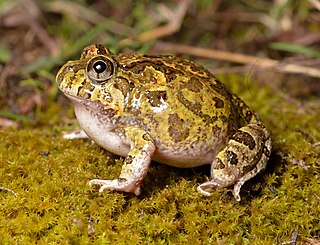
The ornate burrowing frog is a species of ground frog native to Australia. It was moved to the genus Opisthodon in 2006, following a major revision of amphibians, and is now classified in the genus Platyplectrum.

The striped burrowing frog is a species of burrowing frog in the subfamily Pelodryadinae of the family Hylidae. It occurs throughout much of Australia, from northern New South Wales, through eastern and northern Queensland and into eastern Northern Territory. This species was once included in the genus Litoria or Cyclorana.

The Indian burrowing frog is a species of frog found in South Asia.

Metacrinia is a genus of frog in the family Myobatrachidae. It is monotypic, being represented by the single species, Metacrinia nichollsi, commonly known as the Forest toadlet or Nicholls toadlet. It is endemic to Southwest Australia, occurring between Dunsborough and Albany.

The green-thighed frog is a species of tree frog in the subfamily Pelodryadinae. Members of this species are medium-sized, ground-dwelling frogs, and are found in Australia.

Roth's tree frog, or the northern laughing tree frog, is a species of tree frog native to northern Australia and southern Papua New Guinea. Roth's tree frog is a common frog, closely related to Peron's tree frog and Tyler's tree frog.

The New Holland frog, also known as wide-mouthed frog, is a large species of burrowing frog native to northern New South Wales and the eastern three-quarters of Queensland, Australia.

Sphaerotheca dobsonii is a species of frog capable of burrowing. It is found in southern India.

Spencer's burrowing frog is a species of frog native to western and central Australia.
Nyctimystes persimilis, also known as the Milne big-eyed treefrog, is a species of frog in the subfamily Pelodryadinae of the family Hylidae. It is endemic to Papua New Guinea and known from Mount Dayman and Mount Simpson in the Owen Stanley Range.
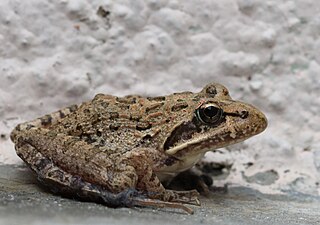
Gray's stream frog is a fairly small species of frog in the family Pyxicephalidae. It is a ground dweller, living mainly in vegetation such as sedges, generally brown, slenderly built and agile, with long, practically unwebbed toes.
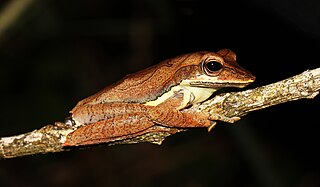
Taruga fastigo is a species of frogs in the family Rhacophoridae. It is endemic to Sri Lanka and only known from its type locality, Morningside Estate near Rakwana. Prior to its description in 2001, it was confused with Polypedates eques.
Walkerana muduga, also known as the Muduga mountain leaping frog or Muduga leaping frog, is a species of frog in the family Ranixalidae. It is endemic to the Western Ghats of India and known from the Elivai Malai range, north of the Palghat Gap in Tamil Nadu. All other known species of Walkerana occur south of the Palghat Gap, and molecular data suggest that Walkerana muduga is deeply divergent from the more southern species. However, there is another, as yet undescribed lineage from north of the Palghat Gap that is known from a single, poorly preserve specimen.




















